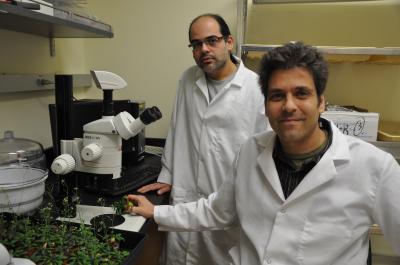RIVERSIDE, Calif. – When a plant encounters drought, it does its best to cope with this stress by activating a set of protein molecules called receptors. These receptors, once activated, turn on processes that help the plant survive the stress.
A team of plant cell biologists has discovered how to rewire this cellular machinery to heighten the plants' stress response – a finding that can be used to engineer crops to give them a better shot at surviving and displaying increased yield under drought conditions.
The discovery, made in the laboratory of Sean Cutler, an associate professor of plant cell biology at the University of California, Riverside, brings drought-tolerant crops a step closer to becoming a reality.
It's the hormones
When plants encounter drought, they naturally produce abscisic acid, a stress hormone that helps them cope with the drought conditions. Specifically, the hormone turns on receptors in the plants, resulting in a suite of beneficial changes that help the plants survive. These changes typically include guard cells closing on leaves to reduce water loss, cessation of plant growth to reduce water consumption and myriad other stress-relieving responses.
The discovery by Cutler and others of abscisic acid receptors, which orchestrate these responses, was heralded by Science magazine as a breakthrough of the year in 2009 due to the importance of the receptor proteins to drought and stress tolerance.

Assaf Mosquna (standing) is a postdoctoral researcher working with Sean Cutler (seated), an associate professor of plant cell biology in the Department of Botany and Plant Sciences at UC Riverside.
(Photo Credit: UCR Strategic Communications.)
Tweaking the receptor
Working on Arabidopsis, a model plant used widely in plant biology labs, the Cutler-led research team has now succeeded supercharging the plant's stress response pathway by modifying the abscisic acid receptors so that they can be turned on at will and stay on.
"Receptors are the cell's conductors and the abscisic acid receptors orchestrate the specific symphony that elicits stress tolerance," said Cutler, a member of UC Riverside's Institute for Integrative Genome Biology. "We've now figured out how to turn the orchestra on at will."
He explained that each stress hormone receptor is equipped with a lid that operates like a gate. For the receptor to be in the on state, the lid must be closed. Using receptor genes engineered in the laboratory, the group created and tested through more than 740 variants of the stress hormone receptor, hunting for the rare variants that caused the lid to be closed for longer periods of time.
"We found many of these mutations," Cutler said. "But each one on its own gave us only partly what we were looking for. But when we carefully stacked the right ones together, we got the desired effect: the receptor locked in its on state, which, in turn, was able to activate the stress response pathway in plants."
Study results appear in tomorrow's (Dec. 20) issue of the Proceedings of the National Academy of Sciences.
Next, the research team plans to take this basic science from the lab into the field – a process that could take many years.